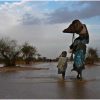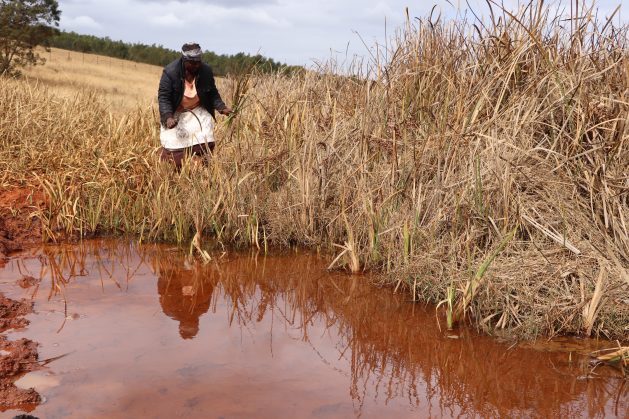
Author and Page information
- This page: https://www.globalissues.org/article/797/cop17-durban-climate-conference.
- To print all information (e.g. expanded side notes, shows alternative links), use the print version:
On this page:
Introduction
 November 28 – December 9, 2011, Durban, South Africa was the venue for the 17th annual United Nations Climate Change Conference, also known as the 17th Conference of the Parties — or COP 17.
November 28 – December 9, 2011, Durban, South Africa was the venue for the 17th annual United Nations Climate Change Conference, also known as the 17th Conference of the Parties — or COP 17.
Predictably and sadly, the same issues complained about at previous annual meetings for the past decade continue to recycle themselves:
- Lack of quality (if any) media coverage
- West stalling on doing anything trying to blame India and China instead
- Lack of funding
- Disagreement on how to address it
- etc.
As the past two decades have shown trying to get global agreement on tackling climate change seems to be futile. By comparison, more focused and limited interest of elites, however, are easier to push through, such as wars based on geopolitical threats (real and imaginary), or economic crises (where banks and other elites most responsible for the crises are bailed out by ordinary citizens).
Furthermore, as the West has generally shown in the past decade or more (even when their economies were doing good) paying now for something that seems to be a problem in the future is hard to accept. It is easier, therefore, to stall and keep blaming China, India and other emerging nations despite the historical inequality of those emissions. But ignoring that makes it easier to hope these emerging nations will pick up the burden of addressing emissions rises.
Generally speaking, media coverage of climate change issues and these conferences has been a mixed bag over the past decade. More recent years has seen increased interest and coverage (though many important issues are glossed over in mainstream media sound-byte style reporting).
However, by comparison, this year’s mainstream media coverage of this crucial conference was close to pathetic, to put it politely. In reality money speaks and so short term and elite/establishment views tend to prevail, which is why governments can so quickly get the 99%
to bail out the banks and the top 1% with many trillions of dollars, while finding billions for fighting even more devastating climate change has taken almost 2 decades so far without any convincing results.
Personally observing mainstream TV news in UK during the week of the Durban talks revealed almost no major headlines until the very last day and even then just a few moments of summarizing an entire two weeks, which of course is not enough. But my own observations were not systemmatic. However, media watchdog Media Lens confirmed my fears of poor coverage, not just in the UK but elsewhere such as the US:
Media interest in the subject has crashed. Dr. Robert J. Brulle of Drexel University describes a
collapse of any significant coverage of climate change in the [US] media. We know that 2010 was a record low year, and 2011 will probably look much the same. If the media doesn’t draw attention to the issue, public opinion will decline.…
Equally disturbing is the variation in media performance across the globe. A wide-ranging Reuters study on the prevalence of climate skepticism in the world’s media — Poles Apart — The international reporting of climate skepticism – focused on newspapers in Brazil, China, France, India, the UK and the USA. The periods studied were February to April 2007 and mid-November 2009 to mid-February 2010 (a period that included the UN climate change summit in Copenhagen and
Climategate). Remarkably, the study concluded that climate skepticism ispredominantly an Anglo-Saxon phenomenon, found most frequently in US and British newspapers.…
And so we find that Britain and the US — the two countries responding most aggressively to alleged
threatsto human security in countries like Afghanistan, Iraq and Libya — are also the two countries least interested in responding to the very real threat of climate change.
Climate Crisis – The Collapse In Corporate Media Coverage
, Media Lens, December 1, 2011
An additional concern that Media Lens also raises is what they described as capitalism trampling on journalism
:
A prime example of this trampling was supplied by the high-profile BBC series Frozen Planet, narrated by David Attenborough, focusing on life and the environment in the Arctic and Antarctic. British viewers will see a total of seven episodes, the last of which,
On thin ice, deals with the threat of climate change.However, viewers in some other countries will only watch six episodes. This is because the BBC packaged the series in such a way that the climate change episode was an
optional extrathat foreign networks could choose to reject. And reject it they did — of 30 networks across the world that have bought the series, 10 have opted not to buy the episode on climate change. Most notable among them is the United States, the world’s leading contributor both to climate crisis and disinformation about the problem.
Climate Crisis – The Collapse In Corporate Media Coverage
, Media Lens, December 1, 2011
In the United States, the annual Tyndall Report, which monitors the daily nightly newscasts of the three main TV outlets (ABC, CBS, and NBC) found just 4 stories on climate change for the entire 2011 on the 3 prime time news shows, two of them being just over 2 minutes each (the other two I cannot access from abroad).
The specific shows monitored are of course not the only news shown in the evenings, and other outlets like CNN are not included, and nor is the Internet, but 2/3rds of people get their news from TV in the US, as Jim Lobe noted in a news story covering this year’s Tyndall report. In that story, Andrew Tyndall, was interviewed by Jim Lobe who also added:
It is safe to say that the network news is complicit in this country’s [the USA] global warming denialism, reinforcing the problem, as opposed to reporting on it.
Arab SpringDominated TV Foreign News in 2011, Inter Press Service, January 2, 2012
And while it seems unimportant to the mainstream media, nature continues its course:
While public concern grows and media coverage collapses, the climate change problem is going through the roof. According to a recent study by the US Department of Energy, the global output of heat-trapping carbon dioxide jumped by the biggest amount on record in 2010. The world pumped about 564 million more tons of carbon into the air in 2010 than it did in 2009, an increase of 6 per cent. The latest figures mean that levels of greenhouse gases
are higher than the worst case scenario outlined by climate experts just four years ago, USA Today reports.…
In the US alone, approximately $3.5 bn is invested annually in lobbying activities at the federal level. In recent years, Royal Dutch Shell, the US Chamber of Commerce, Edison Electric Institute, PG&E, Southern Company, ExxonMobil, Chevron, BP and ConocoPhillips all made the top 20 list of lobbyists. The climate campaign organisation 350.org estimates that 94 per cent of US Chamber of Commerce contributions went to climate denier candidates.
Climate Crisis – The Collapse In Corporate Media Coverage
, Media Lens, December 1, 2011
And these are rises of carbon emissions even during the tough economic conditions.
Media Lens and USA Today are referring to the global carbon project report.
That report adds that although China, USA, India, and Russia accounted for the largest emissions growth in 2010, Per capita emissions of developed countries remain several times larger than those of developing countries.
In other words, significant — and fairer — gains can be obtained if rich nations would tackle their emissions (as has repeatedly been pointed out for some 2 decades).
Reuters summarized the above report and also added that a separate study published recently concluded there was almost no chance of limiting warming to 2 degrees Celsius based on huge investments in polluting power stations.
The summary of that report from the journal, Nature Climate Change, worries: How nations intend to keep within a 2 °C threshold, let alone consider at [sic] 1.5 °C threshold, is unclear in light of current progress
(or lack of).
Despite Europe being on target to meet its Kyoto commitments, global carbon dioxide emissions are still on the increase having spiked by 45% since 1990 to reach a record level of 33 billion tonnes last year.
… to stay below 2 °C throughout this century, annual emissions will have to come down by about 4 billion tonnes of carbon dioxide equivalent from the present day level to about 44 Gt of carbon dioxide equivalent in 2020. Even then, there is just a 66% probability of staying within the 2 °C threshold by 2100. Out of the nearly 200 scenarios studied, only three give a 90% probability of staying below 2 °C this century, and all of those rely on commercially unproven technologies to capture and store carbon-based greenhouse gases. Even with the use of these technologies, there is at best a 50% probability of staying below 1.5 °C this century. Worryingly, if we wait until 2030 for emissions to peak, we’re more likely to be looking to avoid 3 °C this century than 2 °C. In short, the 2 °C threshold is steadily slipping of reach, and 1.5 °C already seems unachievable.
Keeping the average temperature increase within 2 °C of pre-industrial levels implies a target of 450 parts per million (ppm) C02 in the atmosphere. But 450ppm is already feared as not a safe target, but the only practical one to aim for now because of lack of progress amongst industrialized nations in the past 2 decades. And what if we get to 451 ppm?
How much will the world change if we increase CO2 levels to 451 ppm? Time will tell, but one way or the other we may be duplicating in strength in just 200 years what nature itself requires 10,000 years to do. We are applying that forcing beyond the point at which nature has always stopped.
We are duplicating within that short time period the greatest single force on this planet that nature alone has wielded for the past 2.5 million years. But nature does so slowly, carefully and predictably.
We are doing so rapidly, erratically, and without awareness or understanding of the consequences, or even taking long enough to recognize that what we are doing does indeed have an irreversible effect.
Common but Differentiated Responsibility Principle Sidelined Again
As Inter Press Service (IPS) summarized:
What is abundantly clear is the enormous divide between the rich and poor countries. Poor countries want deep cuts in emissions by the industrialized world, and the latter continue to resist significant cuts and legally binding targets.
This site’s section on climate justice has long gone into some detail about
- How the
Common but Differentiated Responsibility
acknowledges that rich nations have emitted most of the greenhouse gases that are causing climate change, that developing countries’ emissions are likely to rise on their path to industrialization and trying to meet basic social and development needs; and that therefore while the goals are the same, the means to tackle climate change will be different. - Year after year at climate summits, it seems this principle is often ignored by some rich nations and their media.
- It has therefore been easier in public to blame nations like China and India for reacting negatively and being uncooperative when faced with pressure to submit to emission reduction targets (before many rich nations demonstrate they can do the same).
Greenhouse gases tend to remain in the atmosphere for many decades so historical emissions are an important consideration.
The following shows that the rich nations (known as Annex I countries
in UN climate change speak) have historically emitted more than the rest of the world combined, even though China, India and others have been growing recently. This is why the common but differentiated responsibilities
principle was recognized.
(Chart updated in January 2012 to add data up to 2008 and preliminary estimates for 2009 and 2010)

No doubt, developing nations should be aware of their recent rise and also do more to curb their emissions. But given their later entry to industrialization and that their per capita emissions are even less than rich nations, more emission reduction could also be achieved per person in rich nations.

The US and others have characterized the campaign for climate justice and equality to the atmosphere as a way to claim climate reparations
; that it is unfair to make the industrialized nations pay for climate emissions into the past century or more at a time when they didn’t know it would cause more harm.
That seems reasonable. However, one of the implications is that any agreement that is subsequently drawn up will, in effect, put disproportionately more burden on the poorer countries to tackle a problem they did not largely cause. The poor are less likely to have the resources to do so, which also means that tackling climate change is less likely to be successful.
This is why rich nations are being asked to seriously think about the type and way they use energy in addition to helping the poorer nations (not necessarily reparations
but through meaningful technology and adaptation assistance — which would be far less costly than the bailouts readily handed to people that did cause a major problem).
In addition, there is little fairness in asking China, India and others to be subject to emission targets when many rich countries didn’t achieve the watered down Kyoto targets themselves.
Some emerging nations are in a grey area — India, China, Brazil, etc are rapidly developing and although they have enormous social and development problems outstanding, some of their wealthy are as wealthy (some more so) as those in industrialized nations. As such, wealthier developing nations aren’t necessarily the target (nor asking) for such adaptation funds.
It is certainly more complex than a few sentences on this page can provide, but the simplification offered by rich country leaders and their media hides this complexity year after year. (See climate justice from this web site for more details on this.)
Durban meeting outcome
The meeting in Durban seemed quite intense; some such as the US and EU were keen on getting China, India and other large emerging nations to sign on to binding emission reduction agreements. These countries were understandably reluctant and even if they may be gaining a stronger voice in the wake of the global/Western financial crisis, this meeting also showed that they haven’t eclipsed the West (at least not yet) on the diplomatic front.
Stephen Leahy, writing for IPS, provides a useful summary of the Durban meeting:
The world is increasingly committed to dangerous levels of global warming with yet another failure by nations of the world to agree to needed reductions in carbon emissions here in Durban.
…
After two weeks and an additional 29 hours of intense and even bitter negotiations, the 193 nations participating in the United Nations climate talks agreed to a complex and technical set of documents called the
Durban Platform.These include the continuation of the Kyoto Protocol, a formal structure for a Green Climate Fund, new market mechanisms, and more.…
Currently the promised emission reductions by industrialised countries and those of China, Brazil, South Africa, India and others under the 2009 Copenhagen Accord guarantee a world that is at least 3.5 degrees Celsius warmer on average according to climate science. It will be double that over large parts of the world. Some analysis says this global average could be even higher rising to four or five degrees Celsius threatening our species with annihilation.
Interestingly, the level of reduction promised by the industrialized world is small compared to its portion of emissions. And it looks as though developing countries have lost out in many ways:
Despite the political posturing by the United States, Canada and even the European Union, the fact is that developing countries’ promised reductions are greater than the industrialised world that are responsible for 75 percent of the total human emissions in the atmosphere.
…
Waiting until 2020 to make major cuts means those cuts will have to be far deeper and far more costly to have any hope of keeping temperatures below two degrees Celsius,
…
The
Durban Platformincludes a second commitment period of the Kyoto Protocol that will begin January 2013, avoiding a gap at the end of the first commitment period finishing next year. The length of the second commitment period is to be decided at COP 18 in Qatar.Developing countries insisted on this condition because Kyoto is the only legally binding emissions reduction agreement. However, it only asked for small reductions from industrialised countries like those in Europe, Canada, Australia, Japan and a few others. The U.S. opted out and Canada ignored its obligations and increased emissions 24 percent. And now Canada, Japan and Russia have said they will take not take part in the second commitment period.
But it is not just developing countries that have lost out; the majority of the first world will have lost out too. Because, as Stephen Leahy rightly notes, trillions are easily and quickly made available to bail out the elite in a financial crises. But when it comes to an even bigger crisis that is further away (and admittedly harder, perhaps, to internalize), funds suddenly seem hard to find; governments are suddenly cash-strapped.
Private sources explicitly include carbon markets as governments from the rich countries frequently cited the financial crisis has tied their purse strings. Civil society and some developing nations noted that governments have made trillions of dollars available for the bank and financial sector and that world’s military budget is more than 10 times what is needed for the GFC [Green Climate Fund].
See also George Monbiot’s note on this, comparing the $7 trillion in US bailout for their own banks, while an estimate for capping climate change globally would require less than a 10th of that: $650 billion. And contrast how quickly the trillions were made available versus how challenging it is for a climate fund to come about.
The other important issue for developing countries is that any climate fund be independent of Western control, somehow, because of the bad experience most poor countries have had in the past.
There was quite a lot of outcry at the stance of the US. Democracy Now! for example reported on the Startling Level of Obstructionism and Defeatism
by the Obama Administration on a U.N. Climate Deal, opting for non-legally binding agreements.
Others, such as the EU, wanted a new legally binding agreement, but as the Third World Network, based in Malaysia, asked, What is the point of a new treaty? In Bali, 2007, the mechanisms were already agreed:
The reality is that the Climate Convention and the Kyoto Protocol that make up the existing legally binding climate architecture desperately need implementing, not replacing. Developed countries appear
progressiveby asking for a legally binding treaty or the mandate for one, when the real truth is that they are violating the current legally binding regime, shifting he goalpost agreed in the Bali Roadmap, and reneging on agreements for a second commitment period of the Kyoto Protocol.
Building on the Bali Mandate
, Third World Network, December 2011
This double-standard (in many areas, not just environment) is a major reason many protests have erupted throughout the industrialized world. The elite seem so far removed from the effects of climate change that perhaps there is no incentive for them to do things about it, effectively, unlike during the recent financial crisis. Instead, resigning to a high level of warming is perhaps acceptable to the elite as they will be better equipped to deal with it.
More information
For more about the issues from other organizations, here are some starting points:
News stories from IPS
Below is a list of stories from Inter Press Service related to the Durban climate conference and its aftermath.
-
Adapting to climate change ‘happening worldwide’, essential
– UN News

The impacts of climate change are already “very visible” and “happening worldwide”, the head of the UN weather agency told the start of the 55th Session of the UN’s Intergovernmental Panel on Climate Change (IPCC) which convened on Monday.
-
Climate Change: Adapt for the Future, Not the Past
– Inter Press Service

SYDNEY and KUALA LUMPUR, Dec 07 (IPS) – Funding for developing countries to address global warming is grossly inadequate. Very little finance is for adaptation to climate change, the urgent need of countries most adversely affected. Also, adaptation needs to be forward-looking rather than only addressing accumulated problems.
-
Climate Change with 8 Billion Humans
– Inter Press Service

PORTLAND, USA, Nov 23 (IPS) – With world population approaching 8 billion humans, the demographic growth of nations is unfortunately largely ignored by governments whenever climate change is considered.
-
Violence, insecurity and climate change drive 84 million people from their homes
– UN News

As more people flee violence, insecurity and the effects of climate change, the number forcibly displaced now exceeds 84 million globally, according to new data released on Thursday by the UN refugee agency, UNHCR.
-
Climate change increasing threats in southwest Pacific: WMO report
– UN News

From rising sea temperatures, to deadly and devastating storms and floods, climate change is increasing threats in the southwest Pacific, the World Meteorological Organization (WMO) said in a report published on Wednesday.
-
COP26: Avoiding Carbon Tunnel Vision: Action on Climate Change Needs an Inter-connected Response
– Inter Press Service

AMSTERDAM, the Netherlands, Nov 10 (IPS) – With the UN climate change conference – COP26 – continuing this week in Glasgow, it’s obvious that there is consensus among a majority of world leaders and key stakeholders that much more needs to be done, if the ambition of keeping global warming to a 1.5-degree increase is to have any chance of being met. Yet talk, as they say, is cheap. Or, in the words of Greta: too much “blah, blah, blah” and not enough action.
-
Magical Thinking on Fertilizer and Climate Change
– Inter Press Service

CAMBRIDGE, Nov 09 (IPS) – As world leaders wrap up the UN Climate Summit in Glasgow, new scientific research shows that there is still a great deal of magical thinking about the contribution of fertilizer to global warming.
-
UN expert criticises boycott of Durban Process against racism, calls for action
– UN News

An independent UN expert on Thursday, strongly criticized countries which continue to boycott the 20-year-old Durban Declaration against racism, and called on them to recommit to combatting discrimination and intolerance, in line with the landmark conference which took place in the South African city, in 2001.
-
An Ambitious, Stakeholder-Driven Climate Change Commitment Ahead of COP26: Eswatini’s Revised Nationally Determined Contribution (NDC) Process
– Inter Press Service

Eswatini, Oct 22 (IPS) – There is no country today that has not experienced the effects of climate change, from changing weather patterns to extreme, devastating weather events.
-
Madagascar: Severe drought could spur world’s first climate change famine
– UN News

More than one million people in southern Madagascar are struggling to get enough to eat, due to what could become the first famine caused by climate change, according to the World Food Programme (WFP).
-
Climate Change: How 1.3 Billion Africans Cause Least But Suffer Most
– Inter Press Service

MADRID, Oct 20 (IPS) – While Africa reportedly causes just 4 percent of global emissions of Carbon Dioxide (CO2) —an acidic colourless gas with a density about 53% higher than that of dry air, causing climate change—, this vast continent, home to over 1.300 billion inhabitants in 52 countries, bears the heaviest brunt of 80 percent of the climate crisis destructive impacts.
-
Fossil fuel production ‘dangerously out of sync’ with climate change targets
– UN News

Despite increased climate ambition and net-zero commitments, governments still plan to produce more than double the amount of energy from fossil fuels in 2030, than the amount that would limit global warming to the Paris Agreement level of 1.5°C.
-
UN-backed report reveals rising climate change risk across Africa
– UN News

Climate change contributed to mounting food insecurity, poverty and displacement in Africa last year, the World Meteorological Organization (WMO) and partners said in a report published on Tuesday.
-
World Food Day: Climate Change is Exacerbating Hunger & Conflict—it’s Time to Break the Cycle
– Inter Press Service

STOCKHOLM, Oct 13 (IPS) – Hunger, violent conflict and the visible impacts of climate change are all on the rise. World Food Day, October 16, is a reminder that we need to talk about the intricate ways that these challenges are connected—and how to tackle them together.
-
Mangrove Blue Carbon for Climate Change Mitigation
– Inter Press Service

NAIROBI, Oct 07 (IPS) – Smelly, boggy, and full of bugs, mangroves’ superpowers are well hidden. However, there is rising confidence that mangroves are the silver bullet to combat the effects of climate change.
-
Extreme Weather the New Normal if Global Warming Increases at Current Speed
– Inter Press Service

UNITED NATIONS, Sep 28 (IPS) – Rondrotiana Barimalala is a climate researcher at the University of Cape Town in South Africa and a lead author for the IPCC report to the recently released Intergovernmental Panel on Climate Change (IPCC) report titled Climate Change 2021: The Physical Science Basis.
-
Pacific nations appeal for solidarity to combat COVID-19 and climate change
– UN News

Pacific Island leaders speaking in the UN General Assembly on Saturday underlined the need for global solidarity, commitment and action to tackle COVID-19 and climate change, two crises which threaten sustainable development.
-
In a Watershed Year for Climate Change, the Commonwealth Secretary-General calls for Urgent, Decisive and Sustained Climate Action
– Inter Press Service

London, Sep 08 (IPS) – This November, five years after signing the Paris Agreement and pledging to limit global warming to 2 degrees Celsius above pre-industrial levels, with a further target of below 1.5 degrees Celsius, world leaders will meet in Glasgow, UK amid COVID-19 pandemic shocks, rising hunger and an Intergovernmental Panel on Climate Change report that warns of more extreme temperature, droughts, forest fires and ice sheet loss due to human activity.
-
Drop coal or climate change will ‘wreak havoc’ across Australian economy
– UN News

Climate change will “wreak havoc” across the Australian economy if coal is not rapidly phased out, a senior UN official warned on Monday.
-
Digital Tech can Help African Island States Cope with Climate Change
– Inter Press Service

BULAWAYO, Zimbabwe, Aug 27 (IPS) – Investing in digital technologies can help African small island developing states (SIDS), vulnerable to extreme weather events, cope with growing impacts of climate change, says the United Nations (UN) Economic Commission for Africa (ECA).
-
A Transformational Approach to Climate Change
– Inter Press Service

NEW YORK, Aug 10 (IPS) – The International Panel on Climate Change (IPCC) issued its starkest report yetexpressing a clear consensus on the rapid changes to global temperatures.
-
A Code Red Warning on the Hazards of Climate Change & an Impending Global Disaster
– Inter Press Service

UNITED NATIONS, Aug 09 (IPS) – A landmark report on the hazards of climate change predicts a devastating future for the world at large.
Authored by the Intergovernmental Panel on Climate Change (IPCC) and released August 9, the study is being described by UN Secretary-General Antonio Guterres as “code red for humanity”— a rallying cry before an impending global disaster.
-
Global warming ‘unequivocally’ human driven, at unprecedented rate: IPCC
– UN News

Climate change is widespread, rapid, and intensifying, and some trends are now irreversible, at least during the present time frame, according to the latest much-anticipated Intergovernmental Panel on Climate Change (IPCC) report, released on Monday.
-
At the UN, Climate Change & Security Must Be Tackled Together
– Inter Press Service

NEW YORK, Jul 13 (IPS) – Could the next wars be triggered by climate change?
Until recently, the question might have seemed like science fiction, but now it is very real. Ethiopia and Egypt are locked in an upward spiral of tensions over the Nile, as a combination of dams and shifting weather patterns pose existential risks to both countries.
-
Conflict, climate change, COVID, forces more people into hunger
– UN News

Global hunger levels have skyrocketed because of conflict, climate change and the economic impact of COVID-19; and one in five children around the world is stunted, UN agencies warned on Monday.
-
Climate Change: Your Choices Matter
– Inter Press Service

TORONTO, Canada, Jun 29 (IPS) – Life is a series of choices. And choices have consequences. When it comes to climate change, some choices have bigger consequences than others, and there’s a startling takeaway: your next “big” decision will play a meaningful role in our collective ability to reach Net-Zero by 2050.
-
Why Pacific Island Nations, like the Federated States of Micronesia, need Climate Change Finance for Food Security Now
– Inter Press Service

SYDNEY, Australia, Jun 28 (IPS) – Robby Nena is one of the many farmers and fishermen on the frontline of climate change in the Federated States of Micronesia (FSM), where coastal flooding and erosion, variable and heavy rainfall, increased temperature, droughts and other extreme weather events are becoming all too common.
-
On climate change frontline, indigenous provide pointers to save planet
– UN News

Indigenous people living on the frontline of climate change could offer potentially ground-breaking insight into biodiversity protection and sustainability, but they urgently need help to withstand a growing number of threats to their way of life, the Food and Agricultural Organization (FAO) said on Friday.
-
Central Sahel: Ground Zero in Tackling Climate Change Through Education
– Inter Press Service

NEW YORK, Jun 16 (IPS) – The climate crisis is amplifying the effects of instability and violence in the world’s poorest countries. Nowhere is this more visible than in Africa’s Central Sahel region, where increasing temperature, floods, droughts and other climate change-induced disasters are triggering conflicts, displacement, and pushing girls and boys into the shadows.
-
UN Scientists: Climate Change and Biodiversity Loss. Two Parts. One Problem.
– Inter Press Service

UNITED NATIONS, Jun 11 (IPS) – Earth is in the throes of multiple environmental crises, with climate change and the loss of biodiversity the most pressing.
The urgency to confront the two challenges has been marked by policies that tackle the issues separately.
Now, a report by a team of scientists has warned that success on either front is hinged on a combined approach to the dual crises.
Author and Page Information
- Created: